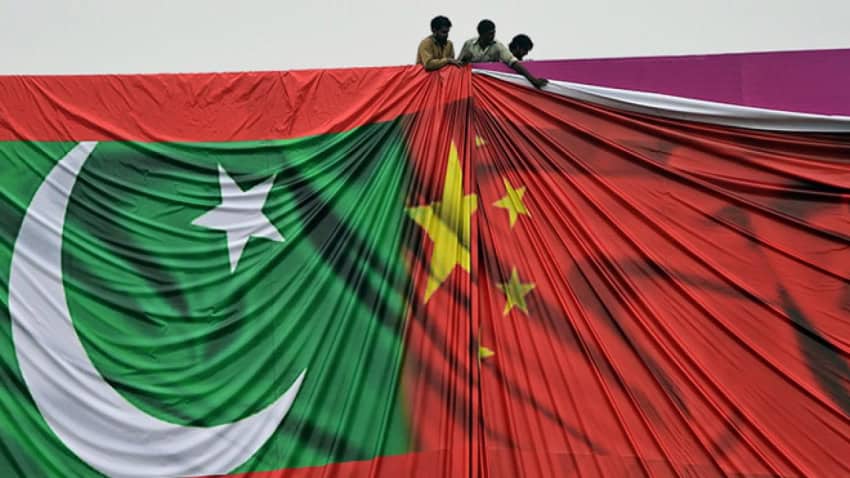In recent years, the Chinese government has been repeatedly raising concerns over the security situation particularly concerning CPEC projects in Pakistan. The government of Pakistan has tried its level best to satisfy the long-term trusted neighbor. Islamabad realizes the importance, sensitivity, and impact of any unpleasantness created by incidents (like targeting of Chinese officials or nationals, etc.) affecting trusted relations between both countries. Pakistan’s government including its military apparatus fully comprehends that security is the one of main hurdles in the realization of CPEC, an important milestone in the Sino-Pak strategic cooperation. Mitigation of threats to this strategic partnership is a mutual concern. Though the government of Pakistan has taken certain measures (such as the establishment of Special Security Division and Special Police Protection Units to provide better security to workers and projects of CPEC) yet due to global power politics, threats to Chinese interests seem to persist in Pakistan in future, even beyond the realm of CPEC projects. Beijing also understands that China needs to read threats in the region beyond the scope of CPEC and Pakistan.
China with high stakes in Pakistan assesses Islamabad’s internal security issues with a critical lens. Since the society in Pakistan remains visibly divided on basis of politics, sects, ethnicity, and tribes, China considers Pakistan’s internal environment fragile. With evident fissures and internal differences in society, the challenges of managing issues even at the grass-root level are estimated by China to increase further. The political environment in the limbs i.e. Gilgit-Baltistan, and Balochistan, continues to simmer with sectarian and sub-nationalist undercurrents. The situation remains inflammable and vulnerable to an abrupt outbreak of armed violence sponsored by hostile intelligence agencies and foreign actors. Youth of the area particularly in Balochistan, Khyber Pakhtoonkhwa, and Gilgit-Baltistan, has become the prime focus of anti-China and anti-CPEC propaganda by hostile agencies. A constant feeling of disorientation and ambiguity plagues the people particularly in Gilgit-Baltistan and Balochistan, which is leading to an eternal sense of incompletion particulary amongst the youth. Bitterness, anguish, and socio-political grievances stoked by the inability of the provincial governments to deal with it have made deep niches into the psyche of local people. Besides, problems related to the economy in the country are being felt at all levels. Thus Chinese are correct to some extent in their fears and apprehensions about the stability of the social environment for their business interests in Pakistan.
Besides having an eye on Pakistan’s internal security matrix, China is deeply concerned about developments in the region. An elevated sense of concern around the fact that China-India tensions in Ladakh might lead to the Indians providing more discreet support for Baloch insurgent groups is given importance by Beijing. The government of Pakistan has repeatedly and openly shared its apprehensions that Indian consulates in Afghanistan were involved in fostering terrorism. The Indian consulate-based R&AW network has been sponsoring centrifugal groups in conducting terror activities against CPEC interests, particularly in Balochistan. While China seemed to have ignored it at the diplomatic level, Islamabad clearly understood the purpose of the special Anti-CPEC desk in New Delhi established with an initial budget of 60 million US dollars. Pakistan also followed how India distributed about Twenty (20) Billion Pak Rupees amongst various belligerent groups including TTP. A portion of this expense was also dedicated to sabotaging CPEC. So, Pakistan did not stop worrying about the future of CPEC but failed to create requisite sensitivity in Chinese friends about the Indian unfair game against CPEC.
In the past few years, the money being spent by India has manifested negatively for CPEC. One of its major achievements is that this money has united the Baloch insurgents against CPEC. In a sudden change in the disposition of Baloch terrorist groups, an alliance of four armed groups BRAS (Baloch Raaji Asjoie Sangar) has emerged. The groups that were previously fighting each other have now joined each other in alliance with one goal i.e. to resist CPEC development in Balochistan. The merger between these groups is an unpleasant surprise for Pakistan’s security forces and the Chinese too. Soon after the establishment of BRAS, it has increased attacks on Pakistani troops and CPEC assets besides killing former Baloch insurgents who earlier surrendered and reconciled with Government under Balochistan Amn Muhaida (Government Surrender Policy). Besides, the physical involvement, the Indian intelligence effort to enable a conducive environment for promoting propaganda against CPEC internationally is also observed. India desires to accrue a set of measures that may serve as a vital component for a long-term Indian strategy that also encompasses its plan about settling the entire Kashmir dispute. On the external front, diplomatic efforts are visible towards sensitizing the international community about its so-called legitimate claims on Azad Jammu Kashmir (AJK) and Gilgit-Baltistan. India is also endeavoring towards isolation of Pakistan and China by skillfully spinning propaganda about human rights violations by Beijing against Uyghurs besides highlighting her reservations about the accession of Gilgit-Baltistan and legality of the CPEC. Indian foreign office is targeting those countries for propaganda that are preparing to get involved in CPEC related developmental or infrastructure projects in Pakistan.
While the Indian posture on CPEC stands completely exposed, other non-state actors in the region such as Islamic State Khorasan Province (ISKP), have also started to activate in wake of the withdrawal of ISAF (US Forces). The ISKP has already shown its interest to operate against Chinese targets. Pakistan’s intelligence agencies are also concerned about the link between the ISKP and Pakistani Taliban (TTP). It is understood by these terrorist organizations that any activity conducted against Chinese interests attracts financial sponsorship (from the hostile intelligence agencies) besides gathering maximum media coverage. ISKP, TTP, and other smaller alien factions have already demonstrated their access, placement, and capability to strike the targets in Pakistan’s mainland and urban areas with deliberate planning. Foreign outfits like the Islamic Movement of Uzbekistan (IMU) and an alliance of fighters from the East Turkistan Islamic Movement ETIM (which has now evolved as Turkistan Islamic Party: TIP) have remained involved in terrorism incidents in Pakistan. The 8th June 2014, attack on Jinnah International Airport, Karachi has already indicated an understanding, cooperation, and alliance between these groups. The TTP has shown its flexibility in accepting alliances as long as it serves the anti-Pakistan and anti-CPEC causes. TTP has even corroborated with sub-nationalist groups like Baloch Liberation Army (BLA), in terms of logistics for operations in Balochistan. Now, in recent years, a Sindhi armed sub-nationalist group i.e. Sindhudesh Revolutionary Army (SRA), has added itself to this Nexus. This was not possible without the Indian connection.
The Tehrik Taliban Pakistan (TTP) figures out prominently as a major threat to Chinese interests in the region. The involvement of Afghanistan’s NDS and its cooperation with India has also been proved to both China and Pakistan. To the embarrassment of Afghanistan and India, in October 2013, accidental evidence came to Pakistan when the US military accidentally captured senior TTP, Latif Mehsud (the number two commander of TTP) traveling in an Afghan army and NDS (intelligence) convoy in Logar, Afghanistan. The Afghan convoy was escorting Latif Mehsud and taking him to National Directorate of Security (NDS) headquarters. This accidental recovery was enough for Pakistan to understand that NDS was supporting Tehreek-e-Taliban at the behest of Indian R&AW. Later, on-demand from Pakistan, the US military handed Latif Mehsud along with his two gunmen acting as his guards. His interrogation in Pakistan revealed great cooperation between NDS and RAW which continues unabated.
While the threat agents in the immediate vicinity and region are the cause of great concern for China, the bigger threat is building up beyond the visible threat horizon. Besides, a significant number of Asians (Pakistanis and Indians) fighting in Syria, Chinese Uyghurs fighters are observed to be one of the largest groups of foreign fighters in the Middle East. Uyghur fighters used Turkish connections to enter Syria and their significant numbers were seen increasing gradually.
The fighters from China and their like-minded militants from Chechnya, and Uzbekistan joined ISIS in two phases. The first joining was from Afghanistan when remnants of al-Ḥizb al-Islāmī al-Turkistānī Uyghur militants and Islamic Movement of Uzbekistan (IMU) volunteered and arrived in Iraq and Syria after taking the oath of allegiance to the caliphate of Abu Bakar Al Baghdadi. These fighters formed a “Turkistan Brigade” (Katibat Turkistani) on arrival in Syria. In the second phase, additional recruits from TIP (Turkistan Islamic Party) arrived at Syria during the outbreak of war and formed part of Katibat al-Ghuraba (KG). Besides KG, other units Katibat Imam al-Bukhari (KIB), as well as other Uyghur groups from Chinese Xinjiang also joined. A number amongst the TIP recruits paid more than 100,000 Yuan to human smugglers to reach overland through Laos, Cambodia, Thailand, and Malaysia, where they were provided with Turkish legal and travel documents. These groups gradually concentrated in Syria’s northwestern Idlib province under the umbrella of Juba Tu Nusra (or Al Nusra Front). Al Nusra later became Hayat Tahrir al-Sham (HTS). Despite fighting along with the side of HTS, the Uzbek and Uyghur groups maintained their separate identity with separate financial sources. Even the arms, ammunition, and technical equipment like wireless sets were observed different from other groups. Anti-Materiel Rifle (Suppressed), Standard AKM rifles and Zastava M84 was common weapon observed with Uyghur Chinese fighters which meant that they had good logistic support. Many Uyghur fighters were killed in the advances of the Syrian Army but TIP was successful in recruiting new fighters through Turkey. Many of the Chinese Uyghur nationals were working on petty jobs in Turkey who were recruited by TIP recruiters living around the neighborhoods of Zeytinburnu and Sefakoy, in Istanbul. So, these proved important in finding fresh recruits. Uyghurs on arrival from Turkey received three-month training where they used Soviet AKM rifles, RPGs, grenade launchers besides undergoing physical training for their conditioning. It is suspected that an NGO and a Turkish Islamic charity group (which were active on the Turkish-Syrian border), were facilitating sending Uyghurs into Syria. A portion of these fighters sent to Syria was well-trained. Some were also said to be those who were arrested earlier by US forces in Afghanistan and later released after detention at Guantánamo (GITMO).
A complex threat for China seems to be brewing in Syria where an anti-China alliance has coming up. In Syria, the Uzbek and Uyghur fighters were only seen in the areas where Hayat Tahrir al-Sham (HTS) had control. It was said that there was an understanding between these terrorist groups that after the battle in the Middle East is over, the HTS will support about six thousand Uzbek, TIP fighters, and others from Central Asian countries to establish a Caliphate and in Chinese Xinjiang and the Central Asian Ferghana Valley. TIP which ran two big size seminaries in Idlib, Syria faces no dearth of recruits. The TIP and another Uyghur group Katiba ul Ghuaraba Turkistan (KGT: meaning Battalion of the immigrants from Turkistan) have established a training area in Latakia mountains where the groups practiced firing drills and tactical maneuvers jointly with the Malhama Tactical group (found by Uzbek fighters who served in Russian Army). Prior to this, there was no identified relationship between TIP and KGT. Later on, it was learned that the Malhama’s leader, Abu Salman Belarussi has entered into some sort of alliance or agreement with the Uyghur groups for their training. The disposition of Uyghur fighters and their alliance with like-minded groups should worry China as a potential threat.
The spectrum of threats against China is diverse. The fact that it is not confined to a particular geographic area makes it difficult for China to address it. The Chinese government is trying to formulate a response to it. However, China cannot settle with a lukewarm riposte planned in isolation. The response has to be partnered with like-minded countries like Pakistan and has to be diverse and broad-spectrum. Beijing needs to take Islamabad on board to generate a coordinated response planned jointly and worked out by both Pakistan and China. This response will range from intelligence gathering by both countries in the region, countering Indian fervent subversion plans, responding to kinetic threats generated by militant groups, and defeat the anti-CPEC overtures at diplomatic and political fronts. Pakistan also needs to deny propaganda opportunities to elements hostile to the CPEC and identify the popular narrative promoting the correct thought process about the Chinese partnership with Pakistan. China must also take Indian involvement against CPEC seriously and raise the issue at all levels to discourage foul play by India. The future of peace in the region lies in economic prosperity and no external agent should be allowed by China and Pakistan to derail and disrupt the hard-worked process started to achieve a better future for the people in the region.
The writer is a versatile analyst, a writer, and a speaker on contemporary issues. He can be reached at Sabbahuddin@gmail.com.














